Today I’m going to explain ukulele string tension, or tightness, and what is and isn’t acceptable.
Throughout my years of playing ukulele, I have encountered both extremes of the tension game. It’s definitely not fun to break a string! But it’s also pretty lame to play floppy, lifeless strings.
Let’s look at some common reasons your strings may feel too loose or too tight and how you can test your string tension.
How Tight Ukulele Strings Should Be
Ukulele strings should be just tight enough to hold the correct pitch. Strings should not be so tight that the tension damages the ukulele or so loose that the strings buzz and are not playable. Use a chromatic tuner to ensure you are staying in the right frequency range and experiment with different string types.
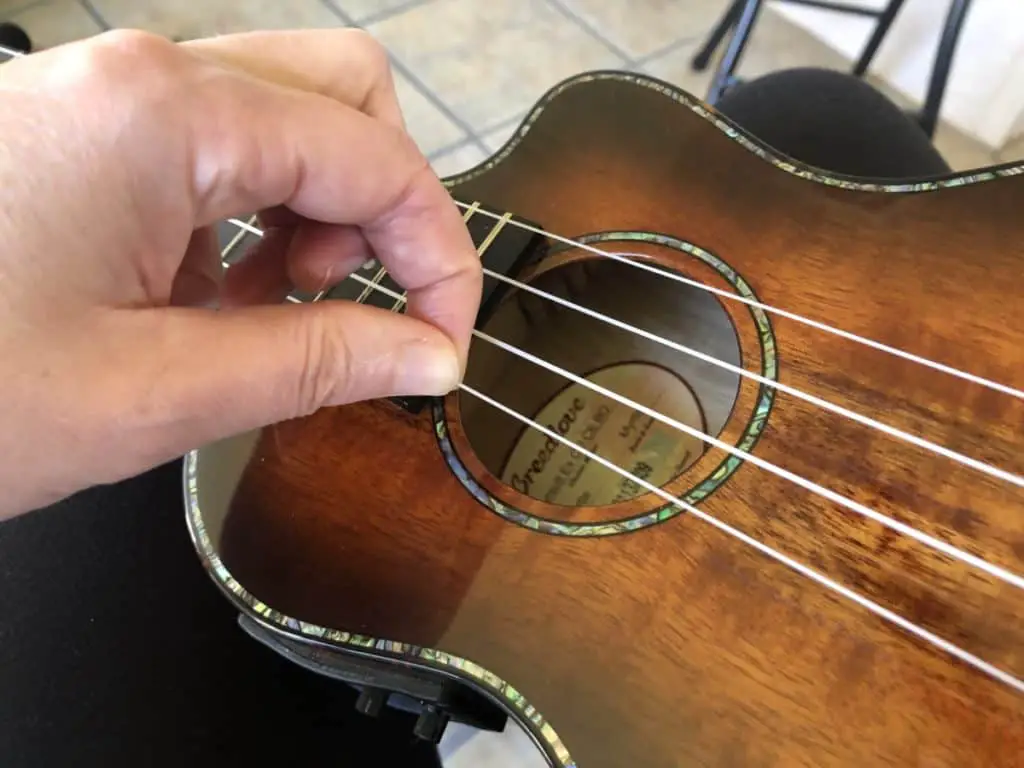
The unique way ukuleles are tuned and the many different string types available can lead to a few commonly encountered reasons your strings may feel too tight or too loose.
Why Your Ukulele Strings Might Feel Loose
When ukulele strings are too loose, they will lack the proper tension to sound their best. This will cause them to feel floppy, sound dead, or buzz when played.
Luckily, loose strings will not harm your ukulele but they may interfere with your ability to enjoy playing.
Let’s explore a few common reasons ukulele strings feel too loose.
1. High G vs. Low G Tuning
The most common cause of too loose ukulele strings is tuning to the wrong octave.
Unfortunately, many tuners don’t distinguish between octaves. If you are a beginner and have a new or wildly out of tune uke, it can be relatively easy to tune to the wrong octave – especially on the G string.
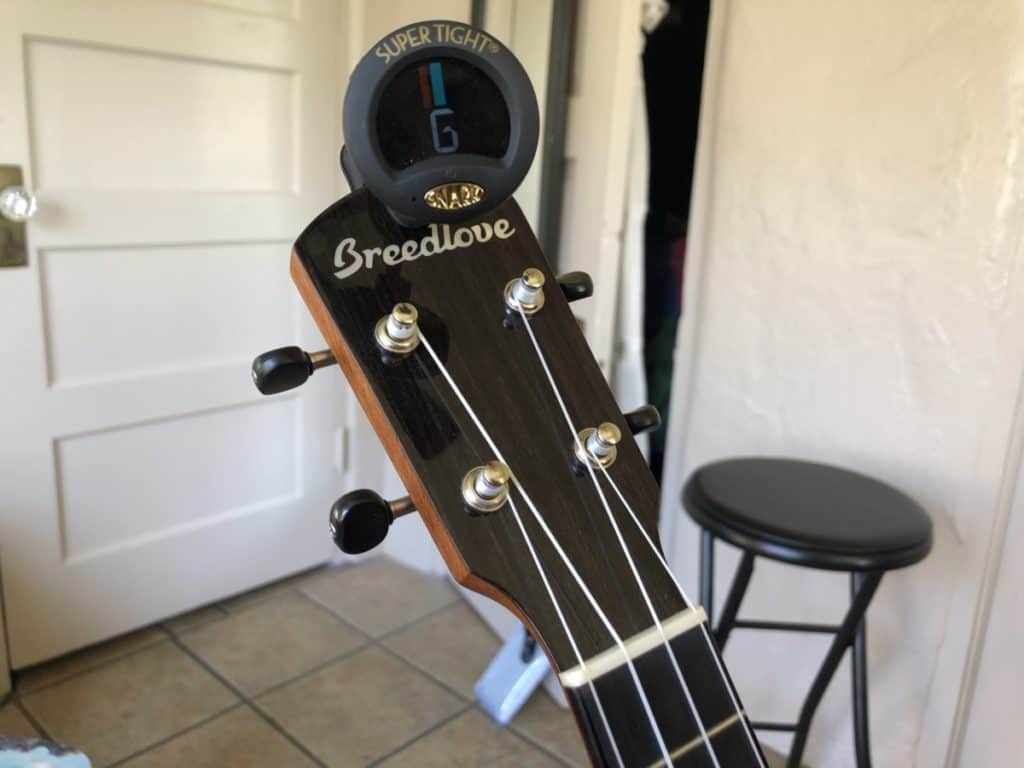
You’ll know this has happened if the pitch of the G string is in line with the other strings, that is, the pitches will in go in order from low to high. This is known as low G tuning and it can be a lot of fun, but you’ll need a special set of strings to properly enjoy it.
The most common ukulele tuning is gCEA, which is known as re-entrant tuning. This just means that the pitches don’t go from low to high linearly as they do on a guitar, for example.
This can get tricky because the G string is tuned an octave above the G that would naturally follow the C string. That’s why it is called a “high G.”
This may seem like complicated music theory, but you can demonstrate this concept to yourself by singing a quick “do-re-mi-fa-so-la-ti-do.” See how that last “do” is higher than the first “do?” That’s because they are one octave apart!
The easiest way to correct this is to use a chromatic tuner, which we’ll cover in the next section.
2. String Age
Age can impact how loose your ukulele strings feel. Brand new strings will alternate between feeling too snug and too loose as they break in.
This is a normal part of the string aging process. Ukulele strings are made out of stretchy materials and it takes a while for them to bed in and feel just right – but they will!
Of course, right about the time they finally break in they will begin to lose their elasticity. Old strings will have stretched to a point where they can’t stretch anymore, and when this happens, they might feel a little floppy.
3. String Size
Ukuleles come in several sizes and strings are packaged to match. While you can play with this a little, you may run into some tension-related issues if you put the wrong set on your uke.
Soprano and concert string sets can be used interchangeably. But if you put a concert string set on a tenor uke, for example, you may notice that the strings feel looser. This is due to reduced tension, and is largely a personal preference. Some people like the feel of more relaxed strings!
4. String Material
Ukulele strings are made out of many different materials, each having unique properties that impact string tension.
If you are used to thinner-gauged dense fluorocarbons, for example, thicker and spongier nylon and nylgut strings might feel a little too floppy to you.
How “tight” or “loose” the strings feel is largely subjective and comes down to your personal preferences. It’s a good idea to try lots of different types and brands of strings to identify what tension you like best!
Why Your Ukulele Strings Might Feel Tight
When ukulele strings are too tight, they may sound harsh or jangly rather than pleasant and mellow, they may be very hard to press down, and they may even break.
In the worst-case scenario, overly tight strings can permanently damage your uke.
Let’s take a look at a few common reasons your ukulele strings might feel too tight.
1. Tuning too High
Because ukuleles are typically tuned to the re-entrant gCEA tuning, there is a greater risk of confusing octaves when tuning. Just like this can cause strings to feel loose, it can go too far the other direction and result in over-tightening.
Tuning too high can have more disastrous results than tuning too low. Most ukuleles can withstand being tuned one full step up (from gCEA to aDF#B) but if you go much higher than that you risk breaking a string or damaging your uke.
It’s easy to get lost as a beginner and start tuning to match the high G string, which will put you an octave too high. This can be avoided by using a chromatic tuner, which we’ll discuss in the next section.
2. String Size
Using a string set optimized for a ukulele of a different size may also cause strings to feel snug.
If you put tenor strings on a concert ukulele, for example, the strings will feel tighter because the gauges are thicker. It is perfectly safe to do this, however, and some people prefer the feeling of more tension!
3. String Material
As I mentioned earlier, ukulele strings are made of different materials with varying properties.
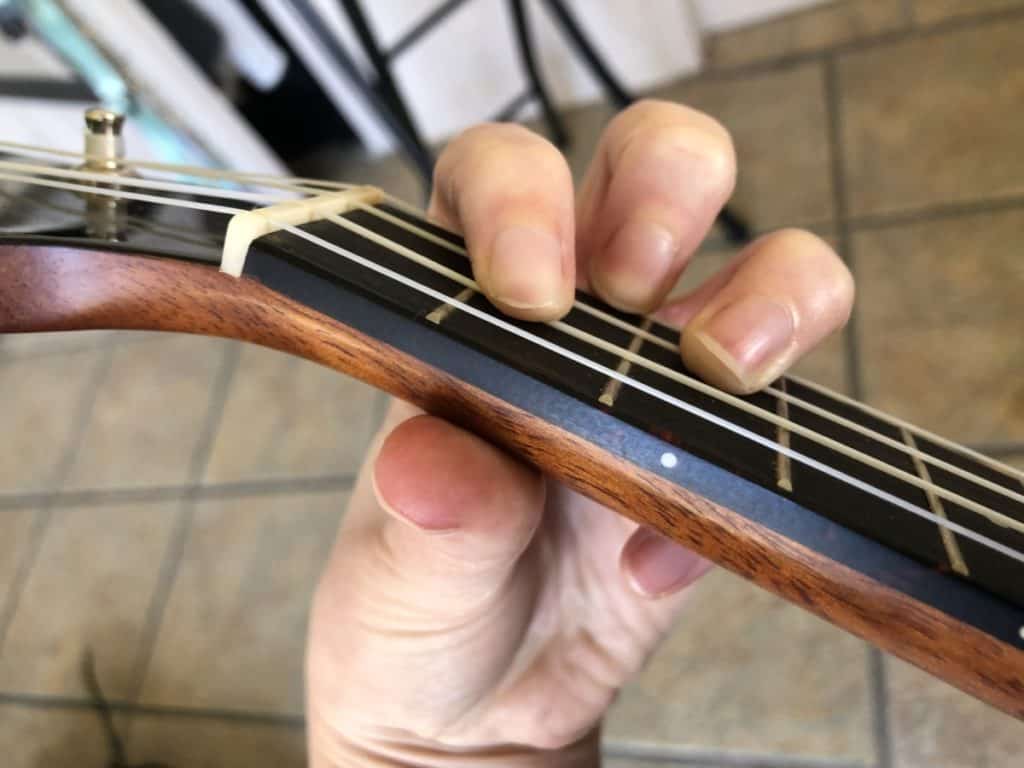
Fluorocarbon and monofilament strings may feel tighter than nylon or nylgut strings due to their density.
All are safe to use it just comes down to personal preference!
How to Test Your Ukulele’s String Tension
Follow these 4 tips to quickly assess how much tension your uke’s strings are holding.
Tip 1: Use a Chromatic Tuner
The best way to ensure you are tuning your ukulele properly, especially when you are a beginner still learning the ropes, is to use a chromatic tuner and tune each string to the correct frequency. You can purchase one or use a free app online (like the BOSS tuner app).
Use the following chart as a guide:
| String | Frequency (in hertz) |
| g/G* | 392/196 |
| C | 262 |
| E | 330 |
| A | 440 |
Check out this video of Andy Guitar tuning a ukulele using a chromatic tuner app.
Tip 2: Check for Signs of Physical Damage
A broken string or a bridge flying off are sure signs that your uke is under too much tension. But what about the less obvious signs?
The first area to check is the bridge. The bridge is glued directly to the top of the uke. Look for signs that it is detaching or peeling off.
Next, check the top surface (sound board) of the ukulele around the bridge. If the strings are too tight, they will pull the bridge forward toward the sound hole. You may see a depression in front of the bridge and a raised area behind it. This is known as “bellying.”
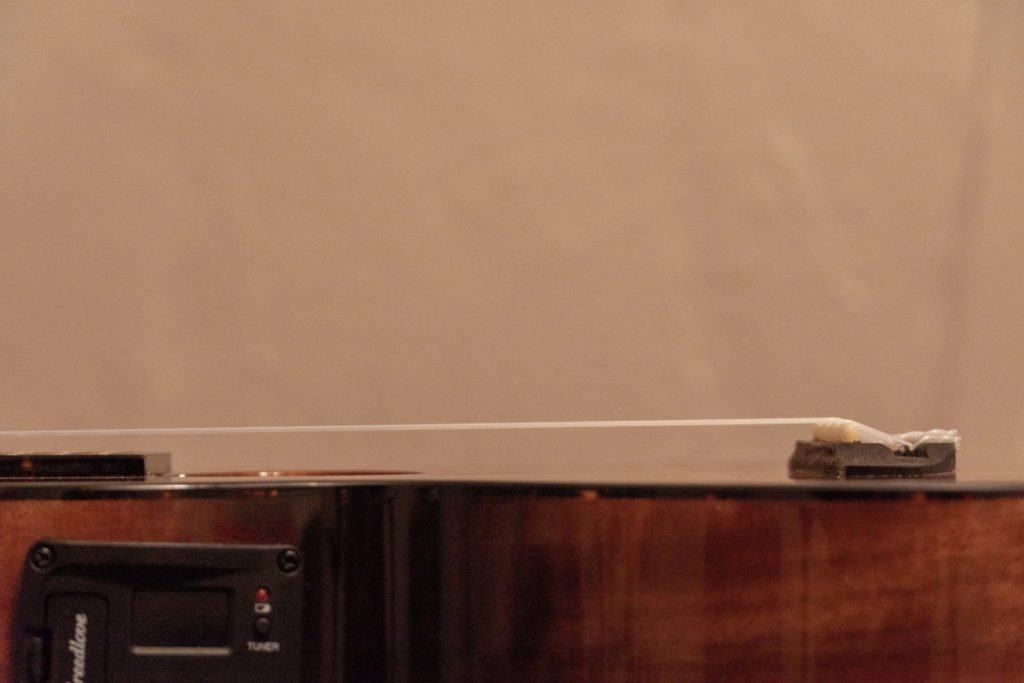
Bellying is a sure sign your ukulele is under too much tension. It is most common on older instruments but can also happen on cheaper ukes that lack the internal bracing to withstand high tension.
Tip 3: Listen and Feel
A ukulele’s tension is “wrong” if it negatively impacts playability. This is a little subjective. But taken too far to either extreme, a ukulele will be rendered unplayable.
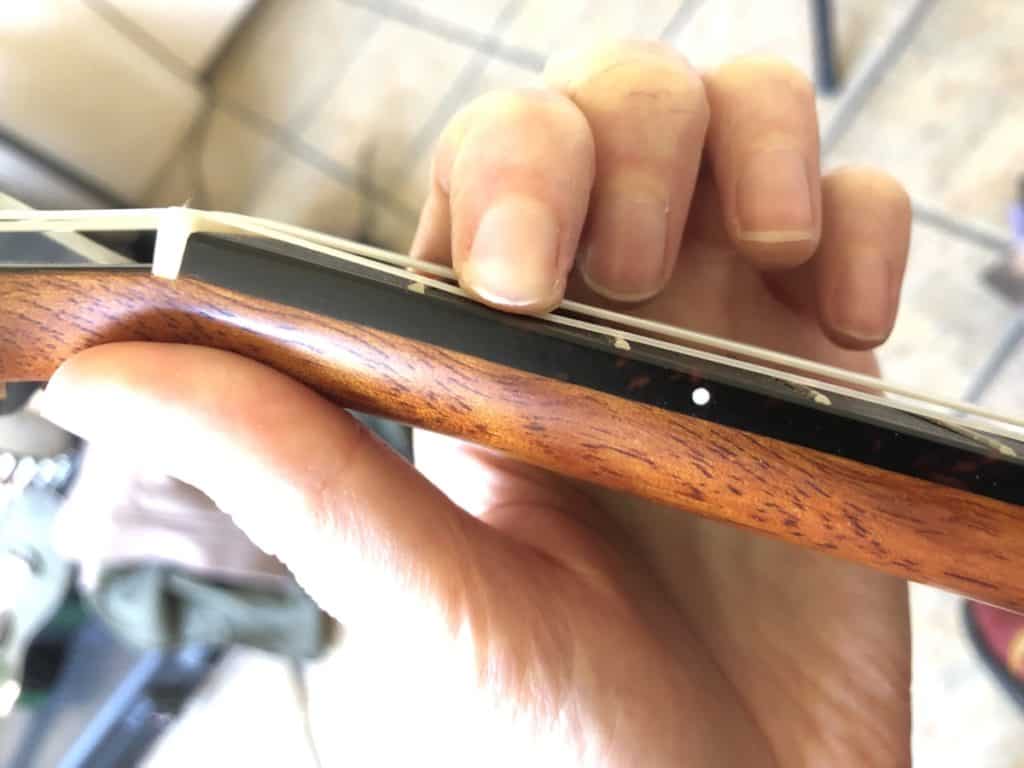
A ukulele under too little tension will feel floppy and sound lifeless. It will lack sustain. Most players would agree that this is problematic.
A ukulele under too much tension will either exhibit dramatic signs of damage like broken strings or a detached bridge or it will be very hard to fret and will sound shrill.
Tip 4: Recognize Personal Preferences
There are a lot of gray areas when it comes to ukulele tension. Ukuleles and strings can safely handle a certain range of tension but you may find you cannot.
If the strings feel too hard to press, then the tension is too high for you as the player. Consider lighter gauge strings or a gentler material like nylon. You can also tune down a half step to f#BD#G# to loosen the strings.
If properly tuned nylon strings still feel too floppy, then you may prefer higher tension. Consider trying some fluorocarbon or monofilament strings, thicker gauge strings, or tuning up a half step to g#C#FA#.
It’s a little bit of a Goldilocks and the Three Bears situation. Feel free to experiment a little as you learn your preferences!
Should You Stretch Your Ukulele Strings?
And if you’re considering stretching your strings…
Stretching your ukulele strings is optional and really only beneficial when the strings are new.
Stretching helps speed up the break-in process for new strings by pulling the slack out of the bridge knots and tuning pegs and elongating the elastic material of the strings so they will hold their tuning.
Strings will stretch in naturally as you play but the process will take longer. There is no benefit to stretching already broken-in strings. In fact, overstretching them can shorten their lifespan.
How Often to Tune Your Ukulele
You should always tune your ukulele before you play it especially when you are a beginner. This will help train your ear to correctly identify notes and chords. Having a good ear will make tuning easier too!
If you just got a new uke or recently changed the strings, expect to tune way more frequently than normal (sometimes after every few minutes of play)!
Once your ukulele’s strings are broken in it will hold its tuning pretty well and you will likely only need to quickly fine-tune it before you play.
Keep in mind that sudden changes in temperature and humidity may throw your uke out of tune so make sure to take your tuner to the beach with you!
If you are a heavy strummer or play a lot of bends you may need to tune more frequently. Many professionals retune several times per gig. And of course, every instrument is different.
Often you won’t need to tune it at all but it’s always a good idea to check!